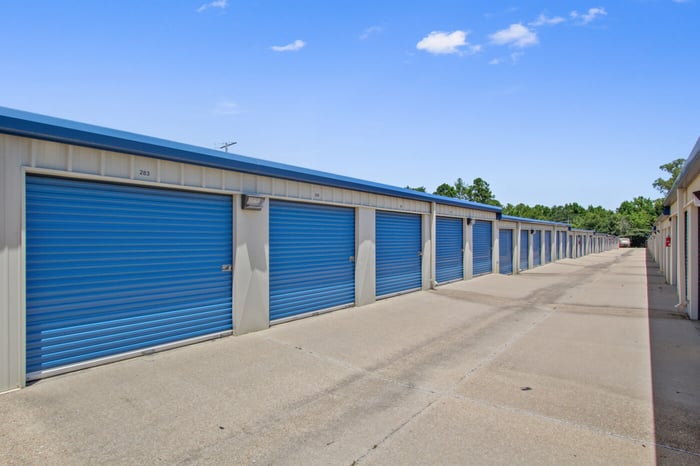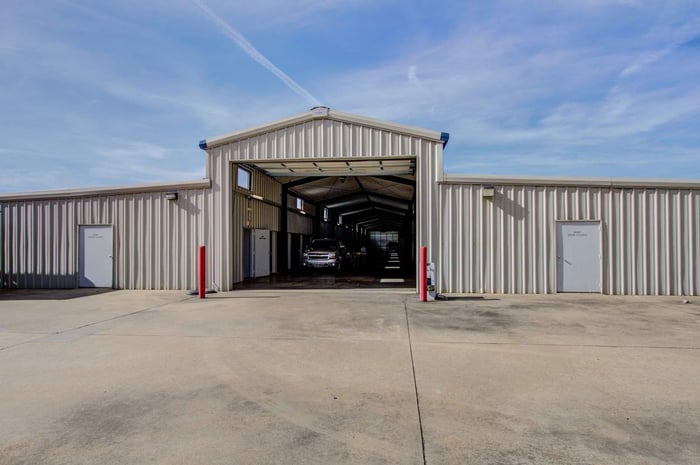If you're an enthusiast of the open water or a seasoned sailor, your boat isn't just a vessel; it's a valued investment. It deserves the best care and protection possible, especially during the off-season. But does your storage solution measure up to the value of your boat? Have you considered the sustained damage that can be caused by fluctuating temperatures and humidity levels in a regular storage unit? Learn why upgrading to climate-controlled boat storage could be a game-changer in maintaining your boat's longevity and resale value. Enter a world where you set sail with peace of mind, knowing that your nautical gem is shielded from harmful elements all year long!
Climate-Controlled vs. Traditional Storage
When it comes to storing your boat, choosing between climate-controlled and traditional storage can have a significant impact on its condition and longevity. Let's explore the differences between these two options and understand why climate-controlled storage is often the preferred choice for boat owners.
Traditional storage, such as outdoor parking or basic indoor units, may seem more cost-effective initially. However, it is essential to consider the long-term effects on your boat. In traditional storage, your boat is exposed to the elements, including extreme heat, cold temperatures, and fluctuating humidity levels. These conditions can lead to damage over time, resulting in costly repairs or depreciating the value of your investment.
Climate-controlled storage, on the other hand, provides a controlled environment specifically designed to protect boats from these potential hazards. The storage units are maintained at a consistent temperature of 80-90 degrees Fahrenheit throughout the year. This regulated temperature helps prevent the negative effects of extreme temperatures on your boat's structural integrity and equipment.
Additionally, climate-controlled storage also offers excellent ventilation. Proper air circulation helps regulate humidity levels within the unit, preventing the growth of mold and mildew that could cause significant damage to your boat's interior and upholstery.
In contrast, a climate-controlled unit maintains constant humidity levels by regulating the moisture in the air. By controlling humidity effectively, you can safeguard your boat's interior from potential moisture-related problems such as rotting wood, deteriorating electronics, or damaged wiring.
Furthermore, insulated, climate-controlled units create a barrier against dust and debris. These units are typically sealed tightly to prevent outside contaminants from entering the storage area. This added layer of protection helps keep your boat's surfaces clean, preserves the quality of your boat's finish, and reduces the need for frequent cleanings or detailing.
Now that we understand the benefits of climate-controlled storage for protecting your boat, let's explore the financial aspect and compare the costs and benefits associated with this option.
Comparing Costs and Benefits
It is natural to consider the financial implications when deciding on storage options for your boat. While climate-controlled storage may have a higher price tag than traditional alternatives, it offers several long-term benefits that justify the investment.
The initial cost of renting a climate-controlled unit might seem higher compared to traditional storage options. However, in the long run, climate-controlled storage can save you money by mitigating potential damage caused by exposure to extreme temperatures or humidity fluctuations. Repairing such damage can be costly and reduce the resale value of your boat.
Think of it like paying for comprehensive insurance coverage for your boat. Though it may require a higher upfront cost, it protects you from significant expenses in the event of unexpected and unfortunate events.
Moreover, climate-controlled storage provides peace of mind by safeguarding not only your boat but also its valuable components—electronics, upholstery, and vital systems. The controlled environment minimizes wear and tear on these components, reducing the likelihood of premature failure or expensive repairs needed due to moisture-related issues.
Lastly, choosing climate-controlled storage also ensures better security for your investment. Facilities offering climate control often provide enhanced security measures such as gated access, surveillance cameras, and personalized entry codes. This added layer of security gives you confidence that your boat is protected against theft or vandalism.
Impact of Climate-Controlled Storage on Boat Longevity
Storing a boat in a climate-controlled unit is the best solution for protecting it from potential sources of damage. By providing a controlled environment, climate-controlled storage facilities offer several benefits that can significantly extend the lifespan of your boat.
One of the main advantages of climate-controlled storage is the regulation of temperature. Extreme heat or extreme cold can be detrimental to a boat's structural integrity and its components. When exposed to excessive heat, materials like plastic and metal can warp or become brittle, leading to potential cracks or breakage. On the other hand, freezing temperatures may cause water inside the boat's engine or plumbing systems to expand, resulting in irreversible damage.
In a climate-controlled unit, the temperature is maintained at a constant level, usually around 80–90 degrees Fahrenheit. This controlled environment ensures that your boat remains free from these temperature-related issues and helps prolong its longevity.
Another crucial factor in boat storage is humidity control. Excessive moisture can lead to mold and mildew growth, causing visible stains and unpleasant odors. Additionally, high humidity levels can contribute to corrosion on metal surfaces such as engine parts or electrical connections. Moisture also poses a risk to electronics and wiring systems, potentially leading to short circuits or malfunctions.
In climate-controlled storage units, humidity levels are closely monitored and regulated. This prevents excessive moisture buildup inside the unit, reducing the risk of mold, mildew, corrosion, and damage to your boat's delicate systems.
Promoting better air circulation and ventilation is yet another benefit provided by climate-controlled storage facilities. Properly circulating air helps prevent stagnant air pockets where moisture could accumulate. By keeping the air fresh and ventilated, the risk of moisture damage to your boat's electrics is significantly reduced.
Furthermore, a climate-controlled storage unit helps keep your boat clean and free from dust accumulation or debris. The facility's design ensures that dust particles are minimized, preventing them from entering the storage unit and settling on your boat's surfaces. This aspect is particularly crucial for boats with delicate finishes or upholstery that can be easily damaged by dust particles.
With the numerous benefits offered by climate-controlled storage facilities, it's evident that they play a vital role in protecting your investment and ensuring the longevity of your boat. However, the advantages don't stop there. These facilities also help prevent deterioration caused by mold, corrosion, and wiring damage.
Deterioration Prevention: Mold, Corrosion, and Wiring Damage
Mold growth can quickly become a nightmare for boat owners. Moisture accumulation in an inadequately stored boat can create ideal conditions for mold development. Not only does mold cause unsightly stains and odors, but it can also lead to health issues for those spending time on the boat.
Climate-controlled storage units address this problem by maintaining optimum humidity levels throughout the year. By carefully controlling moisture, these units effectively inhibit mold growth, safeguarding both the aesthetics and air quality of your boat.
Corrosion is another significant concern when storing boats in less controlled environments. Metal components are particularly susceptible to rusting in high-moisture or salty conditions. Climate-controlled storage plays a critical role in mitigating these risks by providing a dry and controlled atmosphere that inhibits corrosion.
Wiring damage is yet another challenge faced by boat owners during storage. Exposed wires are vulnerable to moisture penetration, which can cause electrical shorts or complete system failures. In a climate-controlled environment, the decreased humidity minimizes the chances of water intrusion into your boat's wiring systems, protecting against potential malfunctions and costly repairs.
By opting for climate-controlled storage, you mitigate these risks and ensure the long-term preservation of your boat. The investments made in climate control outweigh potential repair expenses caused by mold growth, corrosion, or wiring damage.
Setting up the Optimal Storage Environment
When it comes to storing your boat, creating the optimal environment is essential for protecting your investment and ensuring its longevity. Whether you are storing your boat for a few months during the off-season or for an extended period, taking measures to maintain a suitable storage environment is crucial. A well-designed storage facility should address factors like temperature, humidity controls, and ventilation to prevent damage caused by extreme weather conditions and moisture.
Let's take a closer look at the key elements involved in setting up an optimal storage environment for your boat.
Temperature, Humidity Controls, and Ventilation
Maintaining stable temperature levels is vital in any boat storage facility. Fluctuations in temperature can cause condensation inside the vessel, leading to mold growth, rusting of metal components, and deteriorating upholstery. Climate-controlled storage facilities offer a solution by regulating indoor temperatures. They employ heating systems during colder months and air conditioning units to keep temperatures steady during hot seasons. This helps prevent extreme temperature variations that could harm the boat's structural integrity.
Proper humidity control is equally important. Excessive moisture can lead to mold and mildew growth, the rotting of wood, and damage to electronic components. Climate-controlled facilities typically utilize dehumidifiers to maintain optimal humidity levels within the storage units. With these measures in place, you can minimize the risk of moisture-related damages and preserve your boat's condition.
Effective ventilation is another crucial aspect of maintaining an optimal storage environment. Good airflow helps reduce moisture buildup within the storage space and prevents musty odors from developing. Proper ventilation also aids in regulating temperatures evenly throughout the facility. Many climate-controlled boat storage facilities feature ventilation systems that ensure fresh air circulates appropriately while maintaining a controlled environment.
By setting up an optimal storage environment with temperature control, humidity regulation, and proper ventilation, you significantly reduce the risks associated with storing your boat. This investment in the right storage facility pays off in terms of preserving your boat's condition, extending its lifespan, and ensuring a seamless experience when you're ready to use it again.
Enhanced Storage Amenities
Boat owners understand the value of protecting their investment from the harsh elements and potential damage. Traditional outdoor storage options may not provide the necessary protection, leading to costly repairs and deterioration over time. However, climate-controlled boat storage brings a range of enhanced amenities that ensure optimal conditions for your vessel.
First and foremost, climate control ensures a stable environment within the storage facility. Fluctuating temperatures and humidity levels can wreak havoc on boats, causing corrosion, mold growth, and damage to sensitive equipment. Climate-controlled storage facilities use HVAC systems to maintain consistent temperature and humidity levels, safeguarding your boat from extreme weather conditions all year round.
Additionally, these storage facilities often offer advanced security systems to protect your investment. Alongside traditional security measures like surveillance cameras and secure access gates, some facilities employ state-of-the-art monitoring technologies such as motion sensors and intrusion alarms. These security features provide peace of mind to boat owners, knowing that their prized possession is under constant watch.
Climate-controlled storage facilities also prioritize cleanliness and maintenance. They typically have regularly cleaned spaces to prevent dust accumulation and dirt buildup on boats. Some facilities even offer assistance with maintenance tasks such as washing and waxing services, ensuring that your boat stays in pristine condition while in storage.
Above all else, these enhanced amenities contribute to extending the lifespan of your boat, saving you significant expenses in the long run. By protecting it from extreme weather fluctuations, maintaining proper humidity levels, and offering additional maintenance services, climate-controlled storage facilities help preserve the value of your investment and minimize the need for extensive repairs.
Protect Your Boat Investment with Climate-Controlled Storage
Your boat is more than just a watercraft; it's a prized investment and a source of cherished memories. That's why choosing climate-controlled storage for your boat at StorageMax is a wise decision. Our climate-controlled units offer unparalleled protection, safeguarding your boat from temperature extremes, humidity, and the harmful effects of the elements.
Contact StorageMax today to reserve your climate-controlled space and experience the difference it makes in boat protection.


